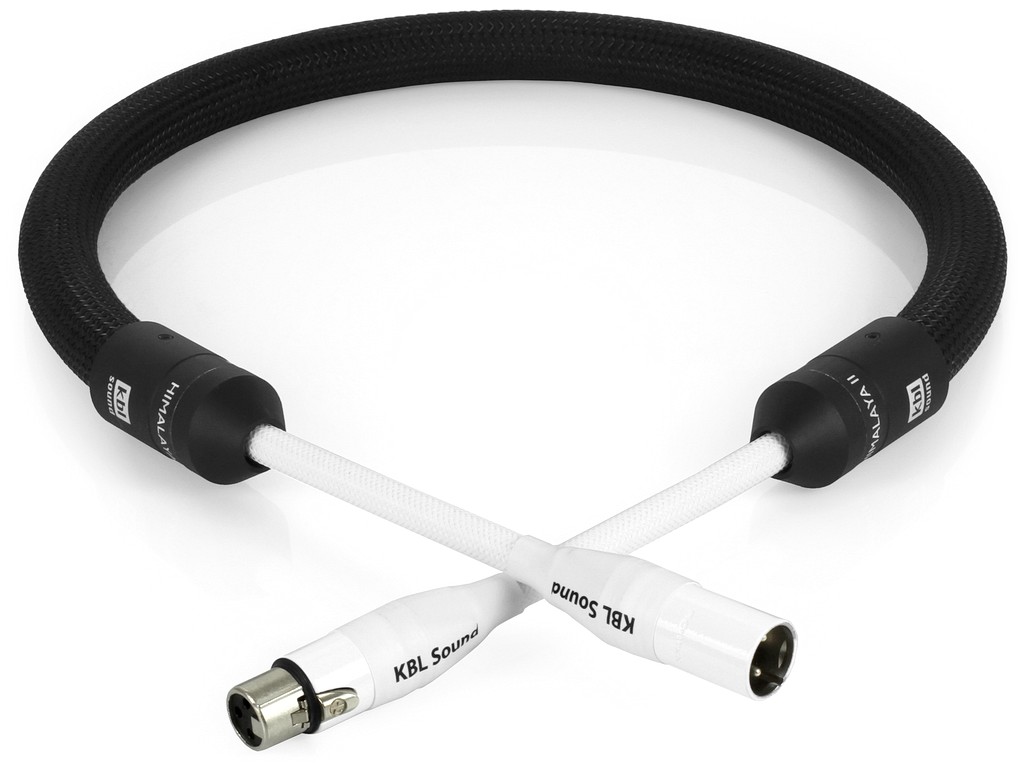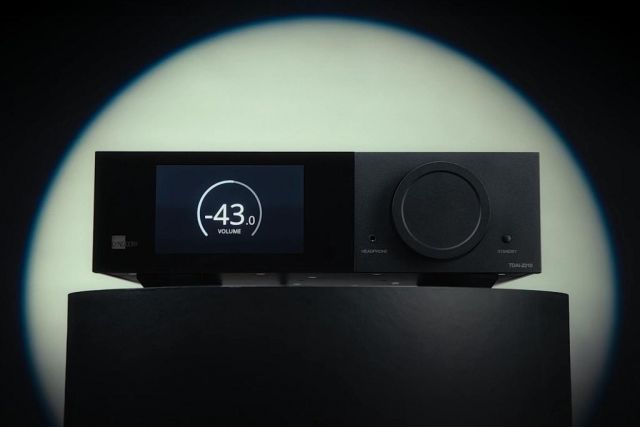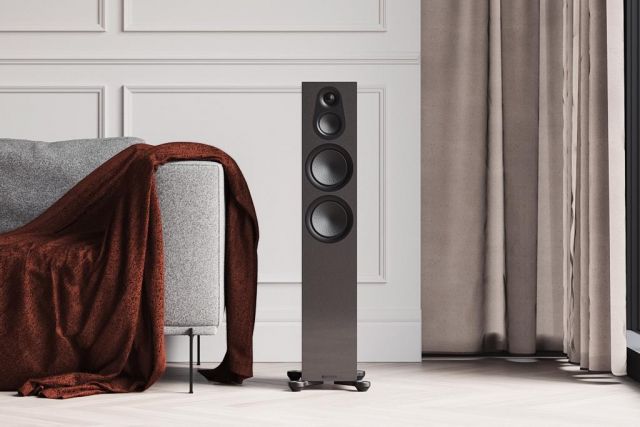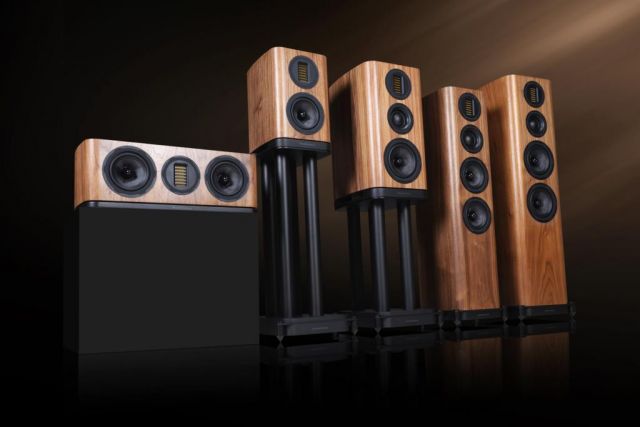
- Reviews
- Posted
KBL Sound Himalaya II
Many manufacturers of high-end cables try to convince us that we are paying for advanced technical solutions, incredibly precise engineering, exotic materials, and details worked out to perfection, such as patented connectors coated with silver, gold, rhodium, or all those expensive metals altogether. To some extent, this is true, for it is difficult to achieve great sound when trying to build such cables from cheap conductors, the worst quality dielectrics and connectors worth two dollars. It's easy to imagine that when all these components are the best money can buy, the price of such cable goes through the roof. Is this madness? Probably yes, but it doesn't change the fact that there is no shortage of people willing to buy high-end cables, as well as companies ready to provide them with what they want. What is shocking for a novice audiophile does not seem so strange to someone who has been building their system for many years, and has already spent tens of thousands of dollars on speakers, amplifiers, sources, and anti-vibration racks.
I first encountered KBL Sound products eight years ago. Since then, the Polish manufacture has been introducing more technically advanced products and raising the bar in terms of sound quality. While some companies built their reputation on specific technical solutions, unique manufacturing methods, or very specific materials, KBL Sound's founder, Robert Szczerbowski, came to the conclusion that the best results can only be achieved by eliminating everything associated with mass production and the industrial nature of such products. In his opinion, a hi-end cable should resemble unique jewelry, exceptional furniture created by the best craftsmen, or a car built from start to finish to the customer's specifications. It can't be an ordinary item coming off the production line. According to Robert Szczerbowski, one can only achieve the goal by experimenting and performing listening tests to find the best materials, geometry, terminations, and what have you. I asked him about many technical details and he always answered the same thing - I tried, more than once, more than twice, and this is what sounded best.
KBL Sound's catalog is focused solely on audiophile accessories. Cabling can be divided into four product lines - Fluid, Zodiac, Red Corona, and Himalaya II. Among power cords two more models appear - Solaris is placed between Zodiac and Red Corona, and between it and flagship Himalaya II and Himalaya II PRO models, we can find Mirror Master Reference cable. Big Foot vibration absorbers are claimed to work the better, the larger the surface they touch both the device and the ground. Unlike in the case of pads, which are supposed to isolate those two elements from each other, usually by minimizing the contact surface, here the vibrations are absorbed by converting kinetic energy into heat inside the absorbers. Another original product of the Polish factory is the RPD Mk 3 power distributor, which does not use any filters, isolation transformers, or protective circuits. However, it has a very impressive housing manufactured from a single block of aluminium on CNC machines, all completed by exotic materials and components such as Furutech sockets and internal wiring made of cryogenically treated OCC monocrystalline copper. The RPD Mk 3 is sold with a wooden base, and its price depends on the number and type of sockets. The basic version costs €3149, and the flagship model is €4739. Bear in mind that we are talking about a power distributor, which does not provide any protection for the connected devices. Its only role is to improve the sound quality.
If you still don't understand what degree of audiophilia nervosa we are talking about here, KBL Sound also offers cable lifters measuring 10 x 8 x 5 cm, made from two very rare types of wood - one comes from trees growing in extreme climate conditions, the other hardens after lying in water for at least several hundred years. This combination is supposed to allow for vibration dissipation, additionally isolating the cables from static charges accumulating near the floor. The price? €135 apiece. To me it's pretty clear that there can be only two possibilities - either someone deliberately preys on the gullibility of "poor audiophiles", trying to sell them magic strips and wooden blocks, or they spent a lot of time and money looking for their Holy Grail, and then decided to share their findings with those, who are also looking for extreme sensations and are ready for big expenses.

Design and functionality
To see which option is true I decided to test a set of cables from the flagship Himalaya II series, launched on the company's 8th anniversary. The prices will, of course, sweep ordinary mortals off their feet. For a one-meter RCA interconnect you have to pay €5249. The XLR version costs €5529. A 1 m digital cable is priced at €3019 and a 1.25 m phono interconnect at €5249. A pair of 2 m speaker cables is priced at €6599, with each additional 0.5 m costing €1185. The 1.8 m power cord costs €5559 and the PRO version is €6379. It's easy to calculate that the value of the set I reviewed, consisting of XLR interconnect, speaker cables, and two power cords are more or less the cost of a decent car. For many audiophiles this is ridiculous, to say the least. These prices are a bit scary even for me because with KBL Sound Himalaya II cables the value of my system almost doubled. But no one claimed that extreme high-end is for everyone. By definition, it's a sport for a handful of very lucky music lovers, on whom such prices ceased to impress long ago. If you are still shocked, I would kindly remind you that in the case of the Tara Labs The Grand Master Evolution interconnect, speaker cable, and power cord the prices are respectively €25,000, €38,000, and €14,000, and if we wanted to buy Nordosty Odin Gold it would be €65,500, €36,500 and €32,500. In the world of extreme high-end audio, there is no record that cannot be beaten. The question remains, however, whether spending so much money automatically takes us to the level of a sonic absolute. Some say the answer is obvious, others argue that the price and the sound quality are two completely separate things - sometimes they go hand in hand, and sometimes they don't.
I probably wouldn't have decided to try KBL Sound's flagship cables, if not for the fact that earlier I got my hands on an XLR from the less expensive, but closely related to Himalaya II, Red Corona series. After many changes in my reference system, I came to the conclusion that its weakest link was the interconnect. Even before I started to look around for a better model, the Red Corona interconnect made its way into my system almost by accident. My guess was correct - this was not a subtle improvement in the sound, it was an earthquake. For the first fifteen minutes, I could not believe what this cable did to the sound. It didn't turn the world upside down, it didn't change the proportions between the bass, midrange, and treble, but in terms of stereo, transparency, and dynamics it resembled a jump from budget earphones to Sennheisers HD 600. I quickly decided Red Corona will stay in my system. I wasn't going to waste my time looking for something better at a similar price. For that budget, you can buy something like Tara Labs RSC Air Evolution, Cardas Clear, Nordost Tyr 2, or Tellurium Q Silver Diamond. But... The cable is installed, the sound is great, so what else is there to complain about? After all, we live in uncertain times, tomorrow's news can start with another mutation of the Coronavirus, an economic crisis, a war, or a climate catastrophe, and I shall spend half a year looking for a cable that will sound as good as the one I already borrowed? I called the manufacturer and said that I probably wouldn't give it back, but before I made the deposit I wanted to listen to the flagship Himalaya II interconnect. Just for fun. The next day three metal suitcases with valuable contents were waiting at my door - not just the interconnect, but also the speaker cable and two power cables.
If my neighbors were looking out their windows at that moment, they must have thought that I had just bought something very suspicious. The cables from the first generation of the Himalaya series were packed in wooden boxes, while the second generation received professional, aluminum cases with combination locks. After pressing the metal buttons on either side the spring-loaded hinges popped off, making a distinctive sound that I only associate with movies in which gangsters deliver guns or diamonds to other gangsters, a secret service agent steals containers of antimatter, or the president prepares to press the red button in response to the information about a nuclear attack. The contents of each case looked no worse. In the smallest one, I found an interconnect, and the two larger ones contained speaker cables and two power cords. All the cases were lined with cushions covered with orange Alcantara with company emblems. Sensitive parts of the cables, such as splitters or plugs, were protected with elastic mesh. In each of the cases, in a separate translucent folder, I found two documents. The first was something like a thank you letter and a manual, or rather a set of guidelines about how to connect and use the cables properly. The second was a certificate of authenticity with a hologram, the specifications of the cable in question, its serial number, and the signature of the company's founder.
The cables themselves look equally impressive and have several things in common. They are all relatively thick, and that is because, according to the manufacturer, the best sonic results come from moving the conductors away from each other. My guess is that they run just below the surface of the protective outer jacket. The large diameter and stiffness can cause problems during installation, so each wire has slightly thinner and more flexible white endings. The splitters are made of black anodized aluminum. As far as the external appearance is concerned, that's pretty much all. There are no strange shapes or surprising mechanical properties to talk about. What impressed me most is the precision of assembly and attention to detail. The designer did not screw around with the plugs, either. In the unbalanced interconnect he uses the WBT 0152 Ag NextGen Signature and 0110 Ag NextGen terminations, in the balanced version these are Neutrik NC3FXX-WT and NC3MXX-WT. In the speaker cable, we have a choice of WBT 0681 Cu forks or 0610 Cu bananas, both types from the NextGen PlasmaProtect series. The power cables use Furutech Fi-48 NCF plugs. One such plug costs €250. Now try to translate this quality to all other elements of KBL Sound's flagship cables, including conductors, insulation, and shielding materials, as well as assembly and packaging, and you will quickly understand why they cost so much. So let's go back to our original question - will all this excess give us better sound, or are those metal cases and expensive plugs just for show, ultimately making the cables perform just a bit better than others?

Sound performance
Because this review is already longer than I planned, I will allow myself to shorten the description of my listening impressions, skipping the stages of preparation, expectations, first impressions, surprise, euphoria, attempts to confront what I heard with any logic, and assessing the relation of mindblowing sound to stratospheric price. I'll explain right away that during the week-long test I had all those moments because the Polish cables can give a discerning audiophile that kind of experience. Their impact on the sound of a stereo system is not negligible. I had no doubt that I'm dealing with really unique equipment. I knew straight away that this is one of these reviews I'll remember for a long time. Some may think that this is always the case when listening to extremely expensive accessories, but this is not true. Sometimes they blend into our system very smoothly, leading us into a false sense that it always sounded so good. We often appreciate such accessories when we send them away. Well, in the case of KBL Sound's flagship cables this scenario seems very unlikely. Here everything can be heard at once, and the first listening session may be quite shocking.
I was surprised not only by the scale of changes but also by how spectacular sound I managed to squeeze out of a system I've been using for almost two years. I knew there's always room for improvement, but I didn't think it had so much potential still waiting to be unlocked. This was not a 3% difference, but a change that could be compared to moving from a good integrated amplifier to a high-end preamplifier and monoblocks. After several days of listening, I came to the conclusion, that the phenomenon of these cables results from the combination of two completely different worlds. The first one is all about balance and correctness, while in the second one all the rules are broken. In some aspects of the presentation, KBL Sound's flagship cables focus on neutrality and, well, high fidelity. If the whole sound was composed that way, we would probably be dealing with cables that are simply unnoticeable, totally neutral, completely transparent. However, in other aspects they go all the way, kicking down doors, opening up a world we would not expect to discover. We can expect unhinged energy, a sense of detachment from reality, a wild joy of playing any music. The sound is so incredibly vivid and thrilling that for a moment we wonder if someone hasn't played a trick on us and changed something else in the system while we were leaning over the amplifier to screw the spades tight.
The Himalaya II does not mess around with tonal balance or timbre. At first, it seemed to me that high frequencies were slightly favored, but then I noticed how much was going on elsewhere, and I realized that thanks to the fantastic microdynamics and resolution we subjectively perceive the sound as louder, clearer, and more instantaneous. This first impression must have been influenced by the fact that the Himalaya II loudspeaker cables replaced the excellent, but completely different Cardas Clear Reflection cables, which offer slightly warmed, delicately smoothened, and deep sound. It's no secret that they can boost the lowest frequencies, especially when they work with a powerful solid-state amplifier. KBL Sound's flagship cables have restored exemplary order in this regard. In this respect, they are completely neutral. This means that we are dealing with cables that should work in any system and any music genre. So we can safely skip the stories about how these cables show their true face in classical or jazz music, or that they work well in heavy rock because they have emphasized, thick, meaty bass. For the owner of KBL Sound flagship cables, such stories will be incomprehensible, because the point is not to change the cabling every time we feel like listening to different music, right? At this level of quality, it's obvious, and I'm glad that the Himalaya II passed this test with flying colors.
The other side of the character of the Polish cables is much, much more interesting. In fact, it was the one that caught my attention during the first listening session and made me wonder how much potential there was in my reference system. The real highlight of the whole show are the aspects in which the Himalaya II doesn't pay attention to conventions, political correctness, or whether the listener is ready to collide with music played in an uncompromising manner. What aspects am I talking about? Soundstage, dynamics, transparency, and unbelievable freedom of positioning even the tiniest sounds where we least expect them, even over our head. A sense of being immersed in music. The ability to catch the smallest details without losing the proper perspective. The impression is as if something has just been unlocked in our system. I don't want to repeat the cliché about the blanket falling off the speakers, but that was exactly like that.
Himalaya II enlarges the soundstage as if our speakers multiplied and instead of one there were three or four boxes on each side, working together to give us an unforgettable listening experience. Suddenly it doesn't make that much of a difference whether a single sound is a meter in front of the base or maybe two meters behind it. The whole image expands so much that every detail can be placed right in front of our head or far in the background. Five, seven, ten meters? I don't know. It's hard to estimate. The most amazing thing, however, was the feeling of being totally surrounded by music, having the room filled with sound to the brim. If you dream about full-range electrostatic or omnidirectional speakers like MBLs, but you know that this dream will not come true soon, you should definitely check out these cables. I couldn't believe that they made such a big difference in my system, and I say that as a "cable guy" - a man who knows very well, that in a good system even power cords can do a lot of good work. But for cables to almost completely change our perception of soundstage? I did not expect that. Before listening to the KBL Sound flagship cables I did not even consider it. Perhaps that is why I experienced such a shock.
Similar, although not so mindblowing effects can be observed in the area of transparency and microdynamics. These aspects are interconnected, so I will say briefly - with these cables music is alive and becomes saturated with details like champagne with bubbles. There are no inhibitions, barriers, unnecessary weight, or traces of compression in the sound. And this in turn translates into our attitude to music. With such a turbocharged system we are able to notice something interesting in each recording. We are curious what our set will show in the next and next track. Not to mention, of course, the DSD files, vinyl samplers, or albums available in the highest possible quality on TIDAL. I had so much fun with KBL Sound's cables that the issue of recording quality receded into the background. Anyway, I suddenly stopped caring about many things.
After several tests in different configurations, I came to the conclusion that the speaker cables and the interconnect were equally responsible for this spectacular sound, and the power cords just dotted the i's and crossed the t's. I must stress, however, that I compared them with the Enerr Transcend Ultimate and Ultimate Source power cords, which are neither cheap nor made of poor quality materials. Admittedly, €2000 per unit is not €5559 but the difference between them was smaller than between the speaker cables and interconnects I used. KBL Sound's flagship cables are uncompromising, no doubt about it. The question remains, however, whether in some systems it will not be too much. It seems to me that the simplest solution is to treat Himalayas II as we are used to treating speakers, amplifiers, and sources. These cables can change a lot. In terms of tonal balance and timbre, they are wonderfully neutral, but in many other aspects, their effect can be a small revolution rather than polishing details. To get real pleasure from it and to make sense of buying the whole set, you need to have a refined system offering a very natural, mature sound. Preferably, one that lacks a bit of openness and flair. For me, the best combination was the Himalaya II interconnect and the Cardas Clear Reflection speaker cable. For two reasons. First, the Enerr Transcenda Ultimate and Ultimate Source power cords were a perfect match for my power distributor, which was also made by Enerr. Secondly, the Cardas Clear Reflection makes a pretty synergistic combination with the Audiovector QR5 speakers, adding a touch of warmth, gently tempering the vibrant character of the AMT tweeter, and making the sound more coherent and musical. Objectively, the Himalaya II is better, and if instead of the QR5s I had, for example, the B&W 702 Signature or the Focal Kanta N°2, I would probably not want to go back to Cardas' cables. Or maybe I am wrong? Maybe a week or two is not enough to get used to such close contact with music? Maybe in every system, it's good to have cables that complement each other, emphasizing completely different aspects of the listening experience?
After testing these cables I'm sure that every high-end audio equipment enthusiast should carry out such an experiment in their own system. If only to see how much can be squeezed out of it, how much of its potential is still locked inside the wires, hidden from our view. And if you think you already know everything, because you tried some of the really expensive Nordost, AudioQuest, Cardas, Acoustic Zen, Acrolink, or Siltech cables, or in fact anything you can think of, I guarantee, that listening to the Himalaya II will not be a waste of time. These cables can clearly improve the sound of a stereo system worth, well, actually, you can enter any amount here - ten, fifty, two hundred, five hundred thousand dollars? And although I did not have the opportunity to try them in such a configuration, something tells me, they will do great in any system you can imagine.


Build quality and technical parameters
Himalaya II is the flagship series of KBL Sound cables. It includes analog, phono, and digital interconnects, as well as speaker cables and power cords in two variants. The manufacturer claims that the best solutions lie in the simplicity of construction and purity of materials, so the conductors are made of metals with the best conductivity - copper and monocrystalline silver. The dielectrics are air, non-pigmented Teflon, and air-foamed Teflon. Of course, we also have the highest quality WBT, Furutech, and Neutrik plugs. All this is to avoid the mechanical character of the sound by minimizing losses in power supply and signal transmission. According to the company's founder, Robert Szczerbowski, interconnects play an extremely important role in a stereo system. That's why Himalaya II interconnects use pure monocrystalline silver conductors manufactured in the OCC (Ohno Continous Casting) process. This gives a 6% gain over OCC copper. The dielectric is air, which is the best insulator for practical use. Depending on the purpose, the cables are shielded in several ways. The connectors are WBT NextGen Signature (in the RCA version) and Neutrik WT (in the XLR version). Himalaya II loudspeaker cables are based on pure copper conductors with a monocrystalline structure as well as on a specific stranding design. The designer claims that their complex geometry completely protects the sensitive signal from the influence of the increasingly ubiquitous RFI and EMI noise. The cables are equipped with an experimental resonance absorption system, which on one hand aims to eliminate magnetic interference, generated by the current flowing through them, and on the other hand, mechanical interference, coming from the environment and disturbing their operation. The speaker cable uses WBT plugs from the NextGen PlasmaProtect series with a reduced contact surface to eliminate the so-called mass accumulation effect. We can choose between WBT 0681 Cu spades or WBT 0610 Cu banana plugs. The Himalaya II power cord uses 9 AWG mono-crystalline copper conductors, which according to the manufacturer ensures comfortable working conditions of any, even the most current-hungry equipment. In the latest generation of this cable, all three wires are physically separated from each other to minimize the mutual influence of magnetic fields generated by the current flowing through them. Thanks to the tunnel damping, the vibration absorption coefficient inside the cable have been significantly improved. The power cord is terminated using exotic plugs - Furutech Fi-48 NCF with piezo-ceramic technology and contact elements subjected to the Alpha process (demagnetizing and cryogenic treatment). The Himalaya II Power Cord is also available with C19 connectors.

System configuration
Audiovector QR5, Equilibrium Nano, Marantz HD-DAC1, Auralic Vega G1, Hegel H20, Unison Research Triode 25, Cambridge Audio CP2, Clearaudio Concept, Tellurium Q Ultra Blue, Albedo Geo, Equilibrium Pure Ultimate, Enerr One 6S DCB, Enerr Tablette 6S, Enerr Transcenda Ultra, Enerr Transcenda Ultimate.
Verdict
Reviewing high-end cables is not something I do every day. Rather, I try to test devices and accessories that fall within my own definition of normality and usefulness - those that offer high-quality sound but remain affordable. However, from time to time I allow myself to try some really exotic stuff and I am glad that I reached for the Himalaya II. These cables can mess with your head. Even if you have a truly high-performance system and have experimented with much more expensive cables, you will probably still be surprised by what the KBL Sound flagships will deliver. In my system plugging in the interconnect alone changed a lot. It was as if someone had opened an invisible window between the speakers. After plugging in the whole set, I was sitting on the couch massacred. I simply couldn't believe my ears. I encourage audiophiles, who do not have to count every penny, to test these cables in their own system. For others, well, I have a small hint. Based on a comparison of interconnects I can say that Red Corona cables provide 80% of the quality I experienced here for less than 50% of the price. Of course, they are still relatively expensive, but it's a very tempting deal. Red Corona is characterized by a slightly warmer sound with a meatier, denser bass and lower midrange. Yes, we lose a bit of precision and dynamics, but what's crucial is that we keep the fantastic, three-dimensional space. For me this option is ideal and the Red Corona interconnect will stay in my system, but I also fully understand those who made such a comparison and decided to go all the way. Sometimes there is simply no turning back.
Technical data
Construction: Multi-strand
Conductors: OCC Silver (interconnect), OCC Copper (speaker and power cable)
Insulation: air, non-pigmented Teflon, air-foamed Teflon
Connectors: Neutrik WT, WBT NextGen PlasmaProtect, Furutech Fi-48 NCF
Price: €5529 (1m XLR interconnect), €6599 (2 x 2m speaker cable), €5559 (1,8m power cord)
Manufacturer: KBL Sound
Sound performance
Editor's rating
8.2Overall9Sound7Functionality9Design10Quality6Price
















